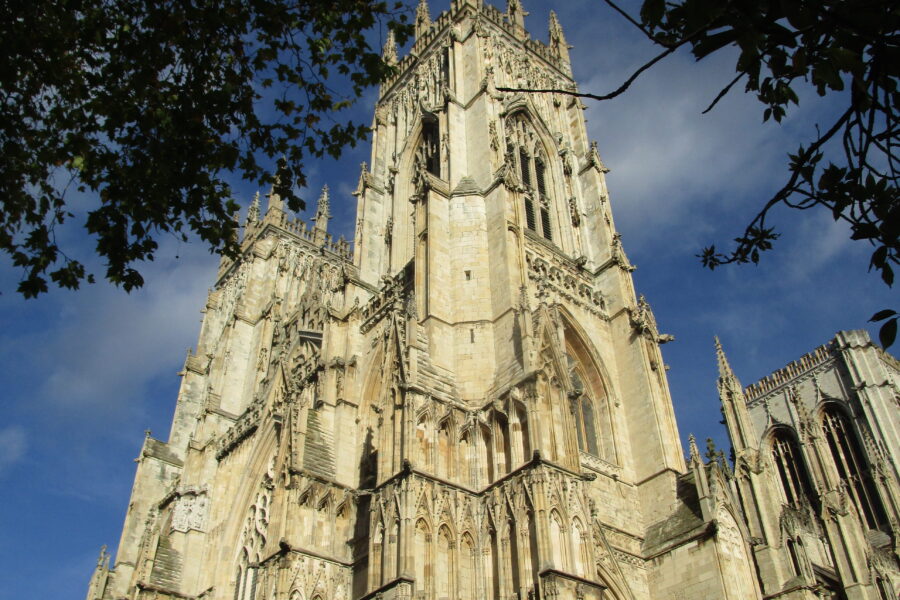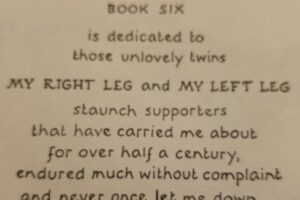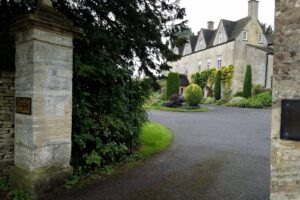We have visited it four times. We could probably visit again and again and again. Each time would be the same—yet different.

Side view of The York Minster.
Popping In
After our delicious lunch at The Lion and the Lamb, Michael suggests we drop in to the Minster—not to look just yet, but to purchase tickets for later in the week.
Walking through the scaffolding surrounded entrance, there are no lines. We discover that our ticket, once purchased is good for a year. We can use it once, twice, three-hundred-and sixty-five times. Even twice that! Why not take a tiny peak.

Scaffolding around the entrance to The York Minster.
We walk down the central aisle toward the nave. The Minster explodes the senses. It is more and less than I expected. It is Gothic. Gaudy opulence does not exist within these walls. It is austere. It is elegant. It soars. It inspires. Filled with light and air and grace, it is quite simply—beautiful.
We sit and stare. We walk. We wander. The tiny aperture in my cell phone’s camera hardly has a chance to capture its essence. I love the monochromatic symphony of stone, gilded with gold only occasionally, and the magnificent stained glass, that lets in the light.

Interior of the York Minster

Michael examining the ceiling of The York Minster.
A Guided Tour
The day we choose for a tour of the Minster is rainy and miserable. Our guide says this is good. The Minster is the world’s largest umbrella—it attracts more tourists who want to get out of the rain than anything else.
Michael and I have become separated while I stop to take pictures in the gloom the rainy day has created within the Minster’s walls. Cell phone, a.k.a. camera still in my hand, I find myself sitting several rows behind him as the tour begins—the back row of the small group—listening to our guide.
I think I am being singled out. Surely not me. But our guide is talking about ancient ways and how the young woman in the back with the phone would probably not be able to survive. He is older than I am, but still… I glance down the row. There are not many of us here. I am the only individual clutching a phone.
One of my least favorite things is for a guide to ask questions his audience can’t possibly answer—if we could we wouldn’t be here. But perhaps it is a way to alleviate nerves—break the ice? Or prove that we need to be sitting here listening to his stories? I am astounded to hear that it takes £9,000,000 a year for the constant upkeep and repair that maintaining the Minster requires.

Restoration work on the stained glass windows of the York Minster.
I am not surprised to find that it took 250 years to build—it is massive. I am surprised to find the reason the current structure exists was because the Minster’s archbishop way back in 1220 traveled to Canterbury, saw their cathedral and decided to do them one better. Construction on the new and improved Minster commenced, building around the existing Norman church, tearing it down, using old stone where needed as they went.
Apparently for many the stained glass windows are the real draw here. Approximately two million individual pieces of glass make up the Minster’s 128 stained glass windows, which is more than half of all England’s medieval stained glass. Too late we learn that we need opera glasses or binoculars to really see the panels. They do climb skyward.

Statues of the Kings of England surrounding the arched entrance leading to the Quire.

Stained Glass window in The York Minster.

Stained Glass windows in The York Minster, York, England October 2017
The Minster isn’t totally perfect. Its flaws are pointed out. We learn about the wood carver Robert Thompson, better known as Mouseman, who signed his wooden furniture creations within the church by carving a small mouse somewhere discreetly on the piece.
We are told stories well beyond the hour allotted—but none of us care. The thing that I will probably always remember is the choir sings in the quire.

We are challenged to find the cat and the mouse among the fifteen statues of England’s kings.
Hearing the Angels Sing
I discover on the Internet that a choral concert will be given on Saturday evening, October 21, inside the Minster. I immediately sign up. Michael wants to hear Evensong sung by the boys choir, so we decide to do it too—all in the same day.
At 4:45 we start our trek across the bridge for the 5:15 service, fighting howling wind all the way to the doors of Minster. Storm Brian just doesn’t seem to want to leave us alone. I mean, the weather is horrid! We, along with everyone else here for Evensong, are told they are closed for the day—“Go around to the side entrance please.”
As the service begins I am transported back in time, listening to the chanting of male voices–the kids are on holiday—sing verses from the Book of Common Prayer which have been largely unchanged since 1549. I tell Michael now I know what the Monks sounded like in the church at Rievaulx so many centuries ago. Ethereal.
And even though the service has lasted over an hour, we still have longer than that to wait for The Ebor Singers Concert at 7:30. Thinking about a quick drink at a warming pub, the cold biting high wind chases us back inside the moment we try walking out the door. The resident attendants give us permission to wait in the church till it is time for the concert to begin. An hour in a quite church, confined to your seat with nothing to do is a long long hour. Michael and I look at each other, both saying, “It could be worse. We could be outside.”

The Quire
At 7 p.m concert attendees begin filtering into the quire where the first part of the concert will begin, then, we have been told, the singers will proceed from place to place in the Minster testing the acoustics in various areas, ending in the Chapter House where the audience will sit in the middle and the choir will surround us.
I am unprepared for the astounding beauty of the sound that soars from the inner depths of these young talented people. It floats and curls upward on a soft cloud toward the tops of the towering columns. At the break one of the singers tells Michael and me that all they have to do is open their mouths and The Minster does the rest. They both—the singers and the church—are glorious.

The Ebor Singers performing under the dome.

The Ebor Singers performing in the Chapter House.

The streets of York at night after the rain as we walk home after the concert.
Who are the Ebor Singers…
The Ebor Singers have earned a reputation as one of the most exciting vocal ensembles in the north of England. The choir draws its members from professional and professionally-trained amateur singers in the region.
For a tiny snippet from their rehearsal for the concert click the link below. I’m afraid it probably won’t do them justice.
https://www.facebook.com/eborsingers/videos/10155853123114207/
The Undercroft
The Minster is a prime example of layered history. The original Norman cathedral was built on the remains of an old Roman fortress. The Minster was then built on the foundations of the earlier Norman cathedral. I am standing on 1,600 years of history, and apparently, to some extent, I can visit each level.

In 1967 the central tower of the church, which weighed about 25,000 tons, was slowly sinking under its own weight, twisting and cracking, putting huge strains on the rest of the building. To save the Minster and the Tower experts were hired to excavate a large hole beneath the cathedral, pump it full of concrete, then drive steel rods down through it to underpin the whole building. In doing this, they uncovered Roman England. Today their discoveries are part of a large underground museum. There is a lot to read down here. This may take awhile.


Along with all of the names and dates and historical information there are two things that blow me away. One is the intensity of the colors of the fresco fragments that have been hidden for so many centuries. The other is a carved scallop shell used for baptisms. It is beyond beautiful—it is exquisitely breathtaking. Apparently the Japanese tourists are fascinated with it too—“They even take pictures of it,” I am told. Well, me too.

Where Did the Name Ebor Come From?
The Roman name for York was Eboracum, based on a native British name for the ancient site. It is thought that the root of the early name was Eburos, an Ancient British personal name, which suggests that the site was founded by someone called Eburos.
For more history click the link below.
http://www.yorkshire-england.co.uk/YorkCity.html










Leave a Reply
Your email is safe with us.